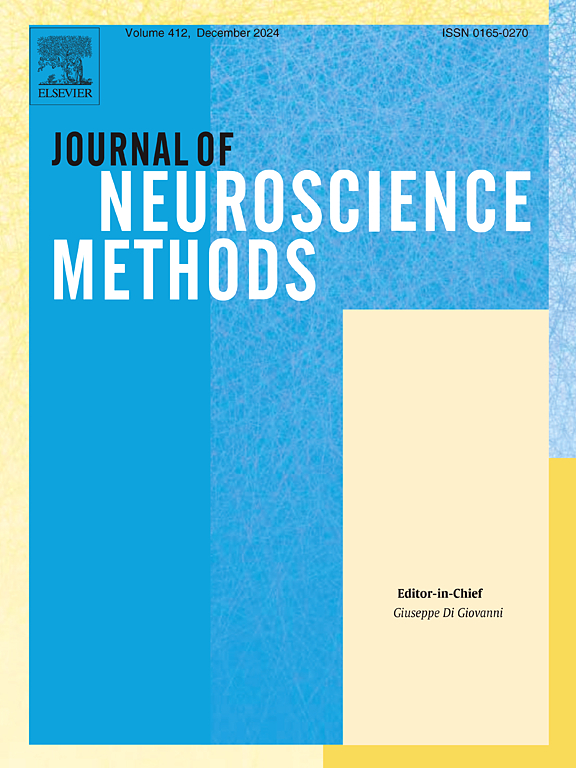T1- and T2-weighted MRI signal and histology findings in suboptimally fixed human brains
IF 2.3
4区 医学
Q2 BIOCHEMICAL RESEARCH METHODS
引用次数: 0
Abstract
Neuroscientific research that requires brain tissue depends on brain banks that provide very small tissue samples fixed by immersion in neutral-buffered formalin (NBF), while anatomy laboratories could provide full brain specimens. However, these brains are generally fixed by perfusion of the full body with solutions other than NBF generally used by brain banks, such as an alcohol-formaldehyde solution (AFS) that is typically used for dissection and teaching. Therefore, fixation quality of these brains needs to be assessed to determine their usefulness in post-mortem investigations through magnetic resonance imaging (MRI) and histology, two common neuroimaging modalities. Here, we report the characteristics of five brains fixed by full body perfusion of an AFS from our Anatomy Laboratory suspected of being poorly fixed, given the altered signal seen on T1w MRI scans in situ. We describe 1- the characteristics of the donors; 2- the fixation procedures applied for each case; 3- the tissue contrast characteristics of the T1w and T2w images; 4- the macroscopic tissue quality after extraction of the brains; 5- the macroscopic arterial characteristics and presence or absence of blood clots; and 6- four histological stains of the areas that we suspected were poorly fixed. We conclude that multiple factors can affect the fixation quality of the brain. Nevertheless, cases in which brain fixation is suboptimal, consequently altering the T1w signal, still have T2w of adequate gray-matter to white-matter contrast and may also be used for histology stains with sufficient quality.
亚最佳固定人脑的 T1 和 T2 加权磁共振成像信号和组织学发现。
需要脑组织的神经科学研究依赖于脑库提供的浸泡在中性缓冲福尔马林(NBF)中固定的非常小的组织样本,而解剖实验室可以提供完整的大脑标本。不过,这些大脑通常是用脑库常用的 NBF 以外的溶液(如通常用于解剖和教学的酒精-甲醛溶液 (AFS))进行全身灌注固定的。因此,需要对这些大脑的固定质量进行评估,以确定它们在通过磁共振成像(MRI)和组织学这两种常见的神经成像模式进行尸检时是否有用。在此,我们报告了解剖实验室通过全身灌注 AFS 固定的五个大脑的特征,由于在原位 T1w 核磁共振成像扫描中看到的信号改变,我们怀疑这些大脑的固定质量不佳。我们描述了 1- 供体的特征;2- 每个病例采用的固定程序;3- T1w 和 T2w 图像的组织对比度特征;4- 取出大脑后的宏观组织质量;5- 动脉的宏观特征和有无血凝块;以及 6- 我们怀疑固定不良区域的四种组织学染色。我们的结论是,多种因素都会影响大脑的固定质量。尽管如此,如果脑部固定不理想,从而改变了 T1w 信号,但 T2w 仍有足够的灰质与白质对比度,也可用于质量足够高的组织学染色。
本文章由计算机程序翻译,如有差异,请以英文原文为准。
求助全文
约1分钟内获得全文
求助全文
来源期刊

Journal of Neuroscience Methods
医学-神经科学
CiteScore
7.10
自引率
3.30%
发文量
226
审稿时长
52 days
期刊介绍:
The Journal of Neuroscience Methods publishes papers that describe new methods that are specifically for neuroscience research conducted in invertebrates, vertebrates or in man. Major methodological improvements or important refinements of established neuroscience methods are also considered for publication. The Journal''s Scope includes all aspects of contemporary neuroscience research, including anatomical, behavioural, biochemical, cellular, computational, molecular, invasive and non-invasive imaging, optogenetic, and physiological research investigations.
 求助内容:
求助内容: 应助结果提醒方式:
应助结果提醒方式:


